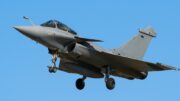November 10, 2022
November 24 will mark the beginning of the 10th month of war in Ukraine. A war that most of us did not expect. A war that is already long and will probably be even longer. A war of a kind and a style that questions the specialists of “military operations”, because it sees two nations confronting each other with an extremely disproportionate balance of power. In terms of aviation alone, the ratio is estimated at 1/9 in favor of Russia, with a total of 1,600 aircraft against 170 at the start of the conflict. And on the ground, a Russian army given for 1,000,000 men, against 10 times less opposite. Even if, Russia has put in action only 150.000 men at the beginning, and if today the figure remains far from the mass that constitutes the Russian army.
One might think, looking at the operations and hearing the comments, that the Air War was lost by the Russians because they actually lost about 100 aircraft, while the Ukrainians lost about 80. But in one case it is less than 10% and in the other it is more than 50%. In fact the air battle did not take place. Few air battles took place. Mostly aircraft shot down by ground/air weapons. Both countries are equipped with ground/air batteries. (As a result, France realizes that it lacks them!)
The war in this context where the sky is “free” therefore takes place on the ground. And no one knows why Russia has chosen such a method for its “special operation”, i.e. its war. In order to answer these questions, it is necessary not only to know the opinions of Western experts, but also to hear the Russian leaders. This is not possible. So we cannot talk about the “feedback” of this ongoing war, but about a temporal analysis at a given point. Today.
I do not return to the causes of the conflict. That is still being debated. I remain on the analysis of what has been observed for 9 months.
Did the Russians think in February that their threat, with 150,000 men in support, would lead Ukraine to lay down its arms? As Clausewitz wrote, “war is a clash of wills”. According to this analysis, the Ukraine would not have had the will to win or to fight against the Russians? Did they think they would be welcomed as liberators? In this hypothesis, therefore, no need for a gigantic arsenal. And the need to avoid the destruction of sensitive, essential, strategic sites: the railroads, the electricity supply, the means of connection (cell phones, social networks) and communication routes, the fuel depots, the pipelines, the large public buildings and the important industrial sites? In this hypothesis obligation to limit the massive bombardments and costly in human lives since the peace was to return in a short time? This is an assumption. And proved to be a serious mistake. Conventional deterrence did not work! The other hypothesis is a “Soviet” vision of war, by the Russians, not having taken into account the modern experiences of “blitzkrieg” dominated from the start by “the air fact”. The Six Day War or the Yom Kippur War for Israel, the 1991 Gulf War. The weakening of Serbia, in ex-Yugoslavia. Wars that began with the mastery of the sky, then ended with a brief succession of ground operations to occupy sensitive points if necessary. In 1991, 28 days of air campaign allowed to have essential intelligence, of human, electromagnetic, satellite origin, and to annihilate all the Iraqi ground/air defenses, all the opposing air force not evacuated in Iran, and more than reduced the infantry and artillery divisions and their armaments, (one speaks of 100.000 dead!) destroyed the Scud ballistic missile launching sites (which had a major terrifying role for a time). When the ground operations started, less than 8 days were then necessary to end the hostilities. Without resistance. The country was devastated. But the war was won at the lowest cost in human lives by the allies against Iraq and in 40 days.
So, it is a fact, Russia has never been the master of the sky of Ukraine. It has not tried to take it over. Nor to destroy the numerous ground/air defenses. This has cost it dearly in aircraft and targets destroyed by Ukrainian ground-to-ground missiles or rockets. It put its ground forces in danger, which had no dissuasive effect and lost a significant quantity of armor. Shameful images. Moreover, the communications remained in service, despite the attacks and cyber attacks of Russia by satellite, the cell phones of the Russian soldiers were constantly located, thus the soldiers, and their units. This is particularly true thanks to Elon Musk’s Starlink multi-satellite network. Thus the tactical information was constantly sent to the Ukrainian leaders. Ukrainians who have also benefited continuously from strategic information and targeting from all the American intelligence means (and also French second suppliers, but on a smaller scale). Thus the Ukrainians knew the positions of the best Russian targets, generally not very mobile, like the USSR, whereas the Ukrainian means were more difficult to destroy because they used a western doctrine of great mobility (as do the Caesar cannons!), and this by Russian forces having little intelligence.
Thus, we learned that the Russians consider the air force as a support tool for the Army, just like our generals at the beginning of the 1914 war, and the chief of staff of the Russian Air Force (“the VKS”) was not an aviator at the beginning of the operations in February!
This is for the first months of this war, before the strategy changes in October with more targeted fire on more sensitive sites in Ukraine, cutting power lines and doing more damage. Western aid, it is true, has had a major effect on the operations carried out by Ukrainian forces. One could say that the warlords are in the U.S., or within NATO, and that the Ukrainian leadership is managing a very effective media strategy, while benefiting from the best military information the West has. But it is not the West that provides the soldiers (at least not much or not according to the political leaders, because it would be to get dangerously involved).
Let’s talk about drones and missiles, suicide drones, rogue drones, and hypersonic weapons. Suicide drones do not exist. They are drones, and therefore capable of returning to their base, unlike missiles which necessarily disappear with their load. But some drones are programmed to carry their charge to the target and thus to destroy themselves. They can hover while waiting for the “pilot” to propose a target. This decision is then written into their program, and cannot be assimilated to an “intelligence” which would advocate suicide. Russian missiles are relatively ineffective because of the lack of information and the mobility of the opposing targets. This is not the case with the missiles fired by the Ukrainians. As for hypersonic missiles, which have so far been few in number, no doubt due to a lack of stock and also of targets worthy of such a cost, they could play a role of “game changer” (changing the scale of the conflict). But this is not what appears to be the case so far.
Thus, in this fight between David and Goliath, we must not neglect the strength of Goliath. It exists. It is not well used. For reasons that are not yet clear. David shows a fighting spirit and an ability to use Western support well, in all areas, which is impressive. Winter is coming. The Russian Goliath can still change his strategy. What is he doing in Kherson? And with the Dnieper, the third largest river in Europe? In any case, Vladimir Putin’s Russia has resources in reserve that should not be overlooked. And it still has the possibility of changing its strategy.
But, and this is the “conclusion” of this story, “air power” should not be questioned. This confuses the most fragile strategists. It is not because the Russians did not “give” aviation and air power that it is not, nowadays, the first power to have and, if necessary, to use, from the start, to win a conflict. This will give content (also in France) to the discussion of budgets and the next military programming law planned for 2024-2030.
Michel Polacco – AeroMorning.com









Be the first to comment on "The “Neglected Aerial Fact”: Temporal analysis of the war in Ukraine after 9 months of clashes"